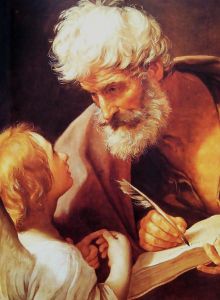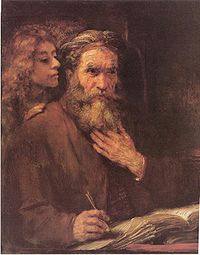Saint Matthew
| Saint Matthew the Evangelist | |
|---|---|
 Saint Matthew and the Angel by Guido Reni |
|
| Apostle, Evangelist, Martyr | |
| Died | near Hierapolis or Ethiopia |
| Venerated in | Roman Catholic Church Eastern Orthodox Churches Eastern Catholic Churches Anglican Communion Lutheran Church some other Protestant Churches |
| Canonized | pre-congregation |
| Major shrine | Salerno, Italy |
| Feast | 21 September (Western Christianity) 16 November (Eastern Christianity) |
| Attributes | Angel |
| Patronage | Accountants, Salerno, Italy, and others, see[1] |
Matthew the Evangelist (מתי/מתתיהו, "Gift of Yahweh", Standard Hebrew and Tiberian Hebrew: Mattay or Mattithyahu; Septuagint Greek: Ματθαῖος, Matthaios) was, according to Christian tradition, one of the twelve Apostles of Jesus and one of the four Evangelists.
Matthew, a former tax collector, composed the Gospel of Christ. It was first published in Judea in Hebrew for Hebrew Christians. It was later translated into Greek. In addition, the Gospel according to the Hebrews is alleged to have been written by Matthew as well.[2]
Contents |
Identity
Among the early followers and apostles of Jesus, a Matthew is mentioned in Mt 9:9 and Mt 10:3 as a former tax collector from Capernaum who was called into the circle of the Twelve by Jesus. He is also named among the number of the Twelve, but without identification of his background, in Mk 3:18, Lk 6:15 and Acts 1:13. He is often equated with the figure of Levi, son of Alpheus, also a tax collector, who is mentioned in Mk 2:13 and Lk 5:27.
Early church fathers Epiphanius of Salamis and Jerome mention a first gospel, the now lost Gospel of the Hebrews, said to have been written by Matthew.[3] Epiphanius does not make his own the claim about a Gospel of the Hebrews written by Matthew, a claim that he merely attributes to the heretical Ebionites.[4] Most modern biblical scholars believe that the attested canonical gospel that came to be ascribed to Matthew's authorship by later tradition was probably originally composed in Greek and by an author who was not a direct companion of the historical Jesus.[5] However, other scholars disagree variously on these points.[6][7][8]
Some use the designation "Matthew the Evangelist" to refer to the anonymous gospel author, and "Matthew the Apostle" to refer to the biblical figure described. Christian tradition holds that they are the same person.[9]
Early life
Matthew was born in First Century Judea. He was a Galilean and the son of Alpheus [10] During the Roman occupation, Matthew collected taxes from the Hebrew people for Herod Antipas. His Tax Office was located in Capernaum. Jews who became rich in such a fashion, were despised and considered outcasts. However, as a tax collector he would have been literate in Aramaic (but probably not Greek or Latin).[9] [11][12]
It was in this setting, near what is today Almagor, that Jesus called Matthew to be one of the Twelve Disciples. After his call, Matthew invited the Lord home for a feast. On seeing this, the Scribes and the Pharisees criticized Jesus for eating with tax collectors and sinners. This prompted Jesus to answer, “I came not to call the righteous, but sinners” [10][12][13][14][15]
Matthew's Ministry
_folio_13r.jpg)
Matthew's ministry in the New Testament is likewise complex. When Matthew is mentioned he usually paired him with Thomas. As a disciple, he followed Christ, and was one of the witnesses of the Resurrection and the Ascension. Afterwards, Matthew along with Mary, James and other close followers of the Lord, withdrew to the Upper Chamber, in Jerusalem.[16][17][18][19] At about this time James succeeded his brother Jesus of Nazareth[20][21] as the leader of this small Jewish sect.[22]
They remained in and about Jerusalem and proclaimed that Jesus son of Joseph was the promised Messiah. These early Jewish Christians were thought to have been called Nazarenes.[23][24] It is near certain that Matthew belonged to this sect, as both the New Testament and the early Talmud affirm this to be true.[25]
Matthew, for 15 years, preached the Gospel in Hebrew to the Jewish community in Judea. Later in his ministry, he would travel to Gentile nations and spread the Gospel to the Ethiopians, Macedonians, Persians, and Parthians. He is said to have died a natural death either in Ethiopia or in Macedonia. However, the Roman Catholic Church says he died a martyr on September 21, and of the Orthodox Church also says he died a martyr but on November 10.[9][26]
Matthew's Gospel

Origen said the first Gospel was written by Matthew.[27][28] This Gospel was composed in Hebrew near Jerusalem for Hebrew Christians and translated into Greek, but the Greek copy was lost. The Hebrew original was kept at the Library of Caesarea. The Nazarene Community transcribed a copy for Jerome which he used in his work.[29] Matthew's Gospel was called the Gospel according to the Hebrews or sometimes the Gospel of the Apostles [30][31] and it was once believed that it was the original to the Greek Matthew found in the Bible, but this has been largely disproved by modern Biblical Scholars.[32]
Commemoration
Matthew is recognized as a Saint in the Roman Catholic, Eastern Orthodox, Lutheran and Anglican churches. His feast day is celebrated on September 21 in the West, November 16 in the East (for those churches which follow the traditional Julian Calendar, 16 November currently falls on 29 November of the modern Gregorian Calendar). He is also commemorated by the Orthodox, together with the other Apostles, on 30 June (13 July), the Synaxis of the Holy Apostles.
Like the other evangelists, Matthew is often depicted in Christian art with one of the four living creatures of Revelation 4:7. The one that accompanies him is in the form of a winged man. The three paintings of Matthew by Caravaggio in the church of San Luigi dei Francesi in Rome, where he is depicted as called by Christ from his profession as gatherer, are among the landmarks of Western art.
See also
References
- ↑ "Saints.SQPN BLOG: Saint Matthew the Apostle". Saints.sqpn.com. http://saints.sqpn.com/saint-matthew-the-apostle/. Retrieved 2010-02-22.
- ↑ Jerome and the Early Church Fathers
- ↑ Mills, Watson E., Richard F. Wilson and Roger Aubrey Bullard, Mercer Commentary on the *New Testament, Mercer University Press, 2003, p.942
- ↑ "What they call a Gospel according to Matthew, though it is not entirely oomplete, but is corrupt and mutilated - and they call this thing 'Hebrew'!" id=rJw3AAAAIAAJ&pg=PA129&dq=Ebion+"corrupt+and+mutilated"&lr=&cd=1#v=onepage&q=Ebion_"corrupt_and_mutilated"&f=false Panarion, 13. English translation by Frank Williams (Leiden, Brill, 1987)
- ↑ Brown, Raymond E., Introduction to the New Testament, Anchor Bible, 1997, p.210–211.
- ↑ Amy-Jill Levine (2001), p.372-373
- ↑ Howard Clark Kee (1997), p. 448
- ↑ D. R. W. Wood, New Bible Dictionary (InterVarsity Press, 1996), 739.
- ↑ 9.0 9.1 9.2 "The International Standard Bible Encyclopedia: Matthew". Studylight.org. http://www.studylight.org/enc/isb/view.cgi?number=T5861. Retrieved 2010-02-22.
- ↑ 10.0 10.1 Mark 2:14
- ↑ Werner G. Marx, Money Matters in Matthew, Bibliotheca Sacra 136:542 (April-June 1979):148- 57
- ↑ 12.0 12.1 Encyclopædia Britannica. "Encyclopædia Britannica: Saint Matthew the Evangelist". Britannica.com. http://www.britannica.com/EBchecked/topic/369730/Saint-Matthew-the-Evangelist. Retrieved 2010-02-22.
- ↑ Matthew 9:9
- ↑ Mark 2:15–17
- ↑ Luke 5:29
- ↑ Acts 1:10
- ↑ Anchor Bible Reference Library, Doubleday, 2001 pp. 130-133, 201
- ↑ Acts 1:14
- ↑
 "St. Matthew". Catholic Encyclopedia. New York: Robert Appleton Company. 1913.
"St. Matthew". Catholic Encyclopedia. New York: Robert Appleton Company. 1913. - ↑ James was called the brother of the Lord, although there is a dispute over what was meant by it.
- ↑ Patrick William, James, the Lord's Brother, BiblioBazaar, LLC, 2009 p.1 ISBN 1113203552
- ↑ James the Just. Books.google.ca. http://books.google.ca/books?id=uqzY1zBtKg0C&pg=PA7&lpg=PA7&dq=just+mary+john+%22II.James,the+brother+of+the+lord%22&source=bl&ots=MRj_si8g__&sig=uur0espW-RiEsfBmaVC4KRCZDuk&hl=en&ei=TBTGSsm3A4HU8QbJzL1G&sa=X&oi=book_result&ct=result&resnum=1#v=onepage&q=just%20mary%20john%20%22II.James%2Cthe%20brother%20of%20the%20lord%22&f=false. Retrieved 2010-02-22.
- ↑ F.L. Cross and E.A. Livingston, The Oxford Dictionary of the Christian Church, Oxford University Press, 1989, p. 597&722
- ↑ Matthew 2:23
- ↑ Bernhard Pick, The Talmud: What It Is and What It Knows of Jesus and His Followers, Kessinger Publishing, 2006 p. 116
- ↑ Eusebius, ''Church History'' 3.24.6. Books.google.ca. http://books.google.ca/books?id=DX89AAAAYAAJ&pg=PA299&dq=%22Eusebius+about+315%22+%22+Matthew,+having%22+%22+first+preached+to+the+Hebrews%22+%22go+to+other+people%22&lr=&num=100&as_brr=3#v=onepage&q=%22Eusebius%20about%20315%22%20%22%20Matthew%2C%20having%22%20%22%20first%20preached%20to%20the%20Hebrews%22%20%22go%20to%20other%20people%22&f=false. Retrieved 2010-02-22.
- ↑ Eusebius, ''Church History'' 6.25.4. Books.google.ca. http://books.google.ca/books?id=Vs9YXAB_axYC&pg=PA18&dq=%22The+First+Gospel,+says+Origen%22++%22written+by+Matthew,+who+once+had+been+a+tax%22&lr=&num=100&as_brr=3#v=onepage&q=%22The%20First%20Gospel%2C%20says%20Origen%22%20%22written%20by%20Matthew%2C%20who%20once%20had%20been%20a%20tax%22&f=false. Retrieved 2010-02-22.
- ↑ Jerome, ''Commentary on Matthew'' 2.12. Books.google.ca. http://books.google.ca/books?id=X2VLANXcZsYC&pg=PA14&lpg=PA14&dq=Matthaei+Authenticum&source=bl&ots=NdyBrgMJDN&sig=hM8xzHN7uqET8gbXJbURQAC7qIs&hl=en&ei=R1FzSrWVAo_aNoy0wbEM&sa=X&oi=book_result&ct=result&resnum=8#v=onepage&q=Matthaei%20Authenticum&f=false. Retrieved 2010-02-22.
- ↑ Jerome, ''On Illustrious Men'' 3. Books.google.ca. http://books.google.ca/books?id=uqzY1zBtKg0C&pg=PA10&dq=%22matthew+surnamed+levi%22+%22composed+a+gospel+of+Christ+at+first+published+in+Judea+in+Hebrew%22&lr=&num=100&as_brr=3#v=onepage&q=%22matthew%20surnamed%20levi%22%20%22composed%20a%20gospel%20of%20Christ%20at%20first%20published%20in%20Judea%20in%20Hebrew%22&f=false. Retrieved 2010-02-22.
- ↑ John Bovee Dods, ''The Gospel of Jesus'', G. Smith Pub., 1858 pp. iv — vi. Books.google.ca. http://books.google.ca/books?id=c2ANAAAAYAAJ&pg=PR4&dq=matthew+%22Gospel+of+the+Apostles%22+OR+%22Gospel+of+the+twelve+Apostles%22+%22various+names%22+%22this+book+of+which+we+speak+contained%22+%22the+life+of+Christ%22&ei=q1keS5SHNqCCygStmsCwCg&cd=2#v=onepage&q=matthew%20%22Gospel%20of%20the%20Apostles%22%20OR%20%22Gospel%20of%20the%20twelve%20Apostles%22%20%22various%20names%22%20%22this%20book%20of%20which%20we%20speak%20contained%22%20%22the%20life%20of%20Christ%22&f=false. Retrieved 2010-02-22.
- ↑ Jerome, ''Against Pelagius'' 3.2. Books.google.ca. http://books.google.ca/books?id=Zm1v-c7fGmgC&pg=PA472&dq=%22gospel+according+to+the+hebrews%22+%22Gospel+according+to+matthew%22+%22gospel+according+to+the+apostles+%22in+Hebrew+characters%22+copy&lr=&num=100&as_brr=3#v=onepage&q=%22gospel%20according%20to%20the%20hebrews%22%20%22Gospel%20according%20to%20matthew%22%20%22gospel%20according%20to%20the%20apostles%20%22in%20Hebrew%20characters%22%20copy&f=false. Retrieved 2010-02-22.
- ↑ Bart Ehrman, Jesus: Apocalyptic Prophet of the New Millennium, Oxford University Press, 1999 p. 43
External links
- St Matthew the Apostle from The Golden Legend
- Apostle and Evangelist Matthew Orthodox icon and synaxarion
- Synaxis of the Holy Apostles
|
Life of Jesus: Ministry Events |
||
|
Hometown Rejection of Jesus, "Physician, heal thyself" |
Events |
Followed by
New Wine into Old Wineskins |
|
|||||
|
||||||||||||||||||||||||||||||||||||